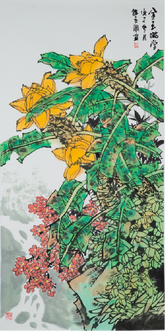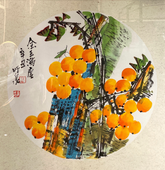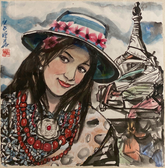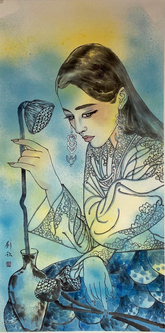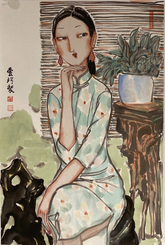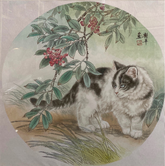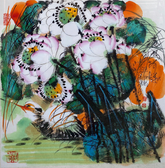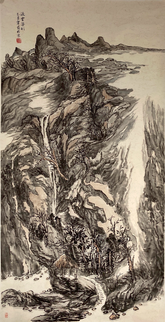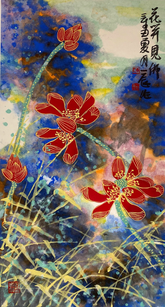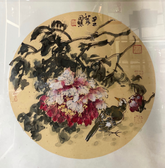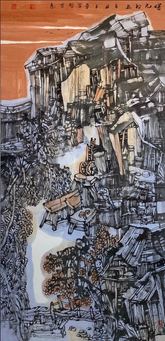-
Chinese painting-"Golden Autumn"Vendor: ChinastyleTitle: 《金秋》/"Golden Autumn"Size: 50X123cmIntroduction to the artist: Lu Dayou, born in Nanjing in 1958, member of the China Artists Association, president of the Central Academy of Painting of the China Democratic National Construction Association, president of the China Ink Art Research Institute, member of...
- $8,000.00
- $8,000.00
- Unit price
- per
-
Chinese painting-"Golden and Jade Full House"Vendor: ChinastyleTitle:《金玉满堂》/ "Golden and Jade Full House"Size: 68X136cmIntroduction to the artist: Han Lipeng, male, the owner of the hall named Zhu, a native of Gutan, a lay Buddhist from Maling. Born in Linyi, Shandong in 1965, he is now a member of Shandong Artists Association.
- $3,000.00
$3,000.00- $3,000.00
- Unit price
- per
-
Chinese painting-"Golden and Jade Full House"Vendor: ChinastyleTitle: "Golden and Jade Full House"Size: 50X50cmAbout the artist: Ren Hengquan, male, from Xintai, Shandong, was born in Shenyang in 1962. He is currently a member of the China Artists Association , a 97' top painter in the Chinese painting circle, a professor at...
- $4,000.00
- $4,000.00
- Unit price
- per
-
Chinese painting-"Girls"Vendor: ChinastyleTitle: 《少女图》/"Girls"Size: 50X50cmAbout the artist: Chen Xiaohua, graduated from Guangxi Art Institute in 1982 with a bachelor's degree. Now he is a member of China Artists Association, his works are collected by Sichuan Art Museum, and his works are published in "Art" and "Art...
- $2,000.00
$2,000.00- $2,000.00
- Unit price
- per
-
Chinese painting-"Girl"Vendor: ChinastyleTitle: 《少女》/"Girl"Size: 68X136cmIntroduction to the artist: Liu Xin, an independent artist, native of Jilin, graduated from Harbin Normal University, studied at the Central Academy of Fine Arts, Tsinghua Academy of Fine Arts, is now a member of the China Artists Association, founder of the...
- $4,000.00
$4,000.00- $4,000.00
- Unit price
- per
-
Chinese painting-"Girl"Vendor: ChinastyleName: 《少女》/"Girl" Size: 68X46cmAbout the author: Hu Ailing, a native of Qianyang, Hunan, is a member of the China Artists Association, a member of the China Women Painters Association, and a member of the Hunan Artists Association.
- $2,000.00
$2,000.00- $2,000.00
- Unit price
- per
-
Chinese painting-"Girl"Vendor: ChinastyleName: 《少女》/"Girl"Size: 68X46cmAbout the author: Hu Ailing, a native of Qianyang, Hunan, is a member of the China Artists Association, a member of the China Women Painters Association, and a member of the Hunan Artists Association.
- $2,000.00
$2,000.00- $2,000.00
- Unit price
- per
-
Chinese painting-"Funny"Vendor: ChinastyleTitle: 《逗趣》/"Funny"Size: 46X69cmIntroduction to the artist: Wang Wenbao, whose real name is Wang Xin, was born in 1954 and is a native of Daixian County, Xinzhou City, Shanxi Province. Member of China Artists Association Member of Shanxi Artists Association, Shanxi Meticulous Painting Society, Shanxi...
- $2,000.00
$2,000.00- $2,000.00
- Unit price
- per
-
Chinese painting-"Funny"Vendor: ChinastyleTitle:《逗趣》/ "Funny"Size: 68X68cmIntroduction to the artist: Wu Yanping is a native of Hebei, a member of the Hebei Artists Association, and a national first-class artist.
- $3,000.00
- $3,000.00
- Unit price
- per
-
Chinese painting-"Fun Off the Shelf"Vendor: ChinastyleTitle: 《架下拾趣》/"Fun Off the Shelf"Size: 68X136cmIntroduction to the artist: Zhou Hui, also known as Shengyin, the owner of Fanghui Hall, a layman in Fengquan, born in Zaozhuang in 1961, a disciple of Mr. Cui Hui, a famous Chinese freehand flower and bird painter, a...
- $4,000.00
$4,000.00- $4,000.00
- Unit price
- per
-
Chinese painting-"Fresh Breeze"Vendor: ChinastyleTitle: 《清风荷趣》/"Fresh Breeze"Size: 50X50cmIntroduction to the artist: Lu Dayou, born in Nanjing in 1958, member of the China Artists Association, president of the Central Academy of Painting of the China Democratic National Construction Association, president of the China Ink Art Research Institute, member of...
- $2,000.00
- $2,000.00
- Unit price
- per
-
Chinese painting-"Fragrant Fragrance"Vendor: ChinastyleTitle: 《清香四溢》/"Fragrant Fragrance"Size: 180X97cmcmPainter introduction: Chang Song (Shi Quan), a native of Yangzhou, Jiangsu. Now he is a member of the China Artists Association, a national senior artist, a painter of the Yangzhou Chinese Painting Institute, the president of the Baoying Chinese Painting Institute,...
- $8,000.00
$8,000.00- $8,000.00
- Unit price
- per
-
Chinese painting-"Fragrant Fragrance"Vendor: ChinastyleName:《香清四溢》/ "Fragrant Fragrance"Size: 34X136cmAbout the author: Lu Fulei, formerly known as Lu Fulei, born in 1976, graduated from the Fine Arts Department of Henan University in 1995, has participated in provincial and national art exhibitions and won awards. Director of the Research Association, member...
- $3,000.00
$3,000.00- $3,000.00
- Unit price
- per
-
Chinese painting-"Four Seasons of Smoke and Clouds in Wonderland"Vendor: ChinastyleTitle: 《四时烟云生妙境》/"Four Seasons of Smoke and Clouds in Wonderland"Size: 70X180cmAbout the artist: Shi Jialu, a member of the Democratic Revolutionary Party. Member of the Chinese Painting Society. Member of China Women Artists Association. Member of Shandong Artists Association. His works have won awards for...
- $4,000.00
$4,000.00- $4,000.00
- Unit price
- per
-
Chinese painting-"Flowing Clouds Invisible"Vendor: ChinastyleName: 《流云无形》/"Flowing Clouds Invisible"Size: 68X136cmAbout the author: Qin Yan, director of the Chinese Painting and Calligraphy Association, deputy director of the Creation Office of the Yuzhou Painting Academy, is currently a member of the landscape painting subject class of Fan Yang Studio of the...
- $5,000.00
$5,000.00- $5,000.00
- Unit price
- per
-
Chinese painting-"Flowers See Buddha"Vendor: ChinastyleName: 《花开见佛》/"Flowers See Buddha"Size: 50X100cmAbout the author: Li Yichen, No. Fochen layman, owner of Dapu Thatched Cottage, was born in Xuzhou, Jiangsu Province in October 1968, and is a member of the Chinese Democratic Progressive. He is a full-time painter in the Chinese Painting...
- $3,000.00
$3,000.00- $3,000.00
- Unit price
- per
-
Chinese painting-"Flowers and Birds"Vendor: ChinastyleTitle: 《花鸟图》/"Flowers and Birds"Size: 50X50cmIntroduction to the artist: Zhou Hui, also known as Shengyin, the owner of Fanghui Hall, a layman in Fengquan, born in Zaozhuang in 1961, a disciple of Mr. Cui Hui, a famous Chinese freehand flower and bird painter, a member...
- $3,000.00
- $3,000.00
- Unit price
- per
-
Chinese painting-"Flowers and Birds in March Spring"Vendor: ChinastyleTitle: 《花香鸟语三月春》/"Flowers and Birds in March Spring"Size: 96X240cmIntroduction to the artist: Han Lipeng, male, the owner of the hall named Zhu, a native of Gutan, a lay Buddhist from Maling. Born in Linyi, Shandong in 1965, he is now a member of Shandong Artists...
- $5,000.00
- $5,000.00
- Unit price
- per
-
Chinese painting-"First Dawn"Vendor: ChinastyleTitle: 《曙光初上》带框/"First Dawn" with frameSize: 79X156cmAbout the artist: Wang Xizhe, born in Lantian, Shaanxi Province, born in 1959, is currently a member of the Central Academy of Painting and Calligraphy of the Jiusan Society, a member of the Chinese Artists Association, the president of...
- $6,000.00
- $6,000.00
- Unit price
- per
-
Chinese painting-"Fate"Vendor: ChinastyleName: "Fate"Size: 97X180cmAbout the author: Wang Guangyuan, Zen Master Youle, commonly known as Wang Guangyuan, nicknamed Shaojian, was born in 1970 at Zu Temple in Dacheng, Hebei Province, and is now a member of the China Artists Association.
- $7,000.00
$7,000.00- $7,000.00
- Unit price
- per
Customer Service ohlyme001@gmail.com-OHLYME
Popular Products
Free shipping on All Orders. No Minimum Purchase


Chinese Painting
Chinese Painting: A Tapestry of Timeless Elegance
Chinese painting, an ancient artistic tradition dating back millennia, encapsulates the spirit, history, and aesthetic sensibilities of China. With its roots embedded deep in the soil of Chinese culture, this captivating art form has evolved into a revered heritage, weaving tales of dynasties, landscapes, and cultural nuances through delicate strokes and vibrant hues.
The Essence of Brush and Ink:
At the heart of Chinese painting lies the mastery of brush and ink. Each stroke on the canvas is a poetic expression, a dance of the brush that captures the essence of the subject – be it nature, people, or philosophy. The artistry lies not just in depiction but in the soulful conveyance of emotion and the vitality of the moment.
Traditional Themes and Symbolism:
Chinese painting encompasses a rich array of themes, often drawn from nature, mythology, or daily life. Plum blossoms, orchids, bamboo, and chrysanthemums, known as the "Four Gentlemen," frequently grace the canvas, symbolizing virtues such as resilience, humility, and purity. Traditional landscape paintings transport viewers to mist-covered mountains, tranquil rivers, and ancient villages, inviting contemplation and reflection.
Ink Wash and Color Palette:
The distinctive use of ink wash, a technique that allows for varying shades of ink to create a sense of depth and texture, is a hallmark of Chinese painting. The restrained yet expressive color palette, often dominated by subtle shades of black, gray, and earth tones, imparts a serene and harmonious quality to the artworks.
Masters and Schools:
Chinese painting boasts a rich lineage of masters, each contributing to a distinct style or school. From the meticulous Gongbi style to the free-flowing Xieyi technique, artists have explored diverse avenues of expression. The works of masters like Shen Zhou, Qi Baishi, and Zhang Daqian are revered not only for their technical prowess but also for the cultural narratives embedded in each stroke.
A Bridge Between Tradition and Modernity:
While deeply rooted in tradition, Chinese painting continues to evolve. Contemporary artists seamlessly blend traditional techniques with modern perspectives, creating a dialogue between the past and the present. Experimental forms, mixed media, and cross-cultural influences contribute to a vibrant and dynamic landscape of Chinese artistic expression.
Cultural Resonance Beyond Borders:
In an interconnected world, Chinese painting resonates globally. Exhibitions, galleries, and digital platforms provide a stage for artists to share their creations with a diverse audience. The universal themes of beauty, nature, and the human experience depicted in Chinese paintings transcend linguistic and cultural barriers, fostering appreciation and understanding worldwide.
Preserving Heritage in the Digital Age:
As the digital age unfolds, Chinese painting finds new avenues for preservation and promotion. Virtual galleries, online exhibitions, and educational initiatives ensure that this profound art form continues to inspire and captivate audiences far beyond the borders of China.
In Conclusion:
Chinese painting is more than strokes on paper; it is a visual symphony, a narrative spun with brushes and ink. It invites viewers on a journey through time, offering glimpses into China's rich cultural tapestry. Explore the elegance, depth, and enduring allure of Chinese painting, where each stroke narrates a story and every artwork becomes a portal to the soul of a nation.
Categories
- Home
- Chinese Zodiac & Astrology
- Chinese Classical Musical Instruments
- Traditional Art & Calligraphy
- Traditional Ceramics & Tea Sets
- Festivals & Cultural Lifestyle
- Chinese Philosophy & Wisdom
- Discover & Inspiration
- BLOG
- Contact
- Catalog
Featured Products
- $3,000.00
- $3,000.00
- Unit price
- / per
- $2,500.00
- $2,500.00
- Unit price
- / per
- $2,000.00
$2,000.00- $2,000.00
- Unit price
- / per
Custom Block
Custom CMS block displayed at the left sidebar on the Catalog Page. Put your own content here: text, html, images, media... or whatever you like.
There are many similar sample content placeholders across the store. All editable from admin panel.
Recently Viewed Products
- Choosing a selection results in a full page refresh.









